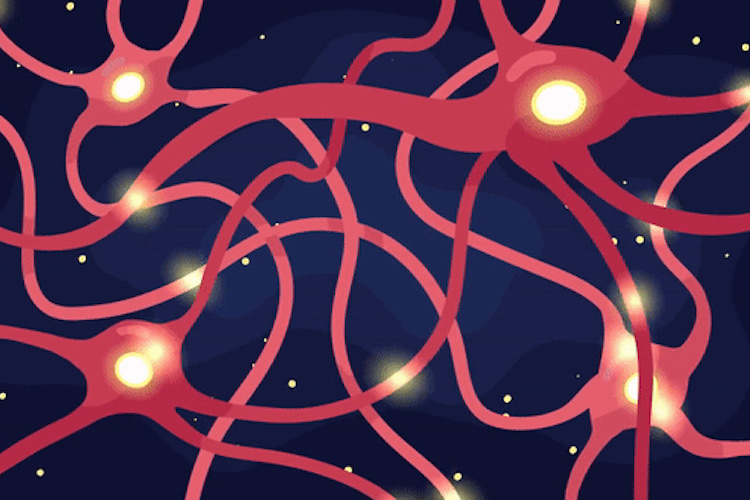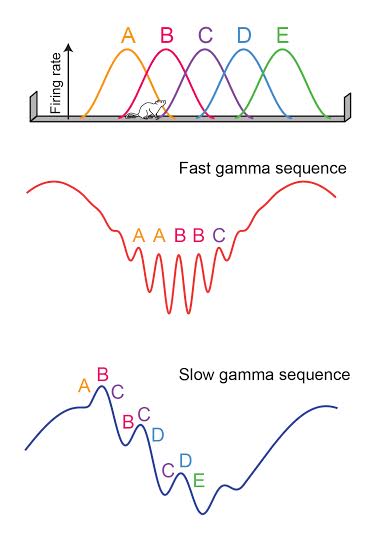How are spatial memories compressed in our brain?
Researchers propose a new model of spatial coding in theta sequences during slow and fast gamma rhythms
news | February 8, 2016

In January 2016 Neuron published an article called “‘Spatial Sequence Coding Differs during Slow and Fast Gamma Rhythms in the Hippocampus”. We asked one of the authors, Dr. Chenguang Zheng from the University of Texas at Austin, to comment on this study.
Gamma rhythms and spatial coding
We proposed a new model of spatial coding in theta sequences during slow and fast gamma rhythms (Figure 1). During periods of fast gamma rhythms, sequences of place cells accurately track an animal’s ongoing trajectory, and discrete locations are represented within individual fast gamma cycles. Within a particular window of time, equivalent to several fast gamma cycles nested within a theta cycle, relatively short spatial paths are represented. During periods of slow gamma rhythms, sequences of place cells represent paths extending ahead of an animal’s current location. Within a particular window of time, corresponding to several slow gamma cycles within a theta cycle, relatively long paths are represented.
We investigated how temporally compressed spatial sequences could occur during slow gamma rhythms. Sequences of locations, rather than discrete locations, were found to be represented within slow gamma cycles, allowing for time-compressed representations of space. Across successive slow gamma cycles, a given place cell spiked at earlier and earlier slow gamma phases as the spatial path advanced through the location represented by that place cell (“slow gamma phase precession”). Moreover, place cells spikes that occurred at early slow gamma phases represented earlier locations in the spatial trajectory. Spikes that occurred at late slow gamma phases represented later locations.In contrast, during fast gamma, individual locations were represented within individual fast gamma cycles. Spikes occurred consistently around the same fast gamma phase. Therefore, the slow gamma phases of place cell spikes code spatial information,whereas fast gamma phases of place cell spikes do not.
Figure 1: A novel theory of spatial coding in theta sequences during slow and fast gamma rhythms. In this theory, longer paths are coded during slow gamma than during fast gamma. This is because sequences of locations, rather than discrete locations, are coded within individual slow gamma, but not fast gamma, cycles.
Place cells and theta rhythms
Place cells, hippocampal neurons that fire in particular locations of a given environment, were first discovered by John O’Keefe in the 1970s. This important finding inspired and supported the hypothesis that the hippocampus plays a significant role in spatial navigation and spatial memory. Interestingly, the activities of place cells are organized by theta rhythms, a type of brain rhythm with frequencies ranging from ~4 -12 Hz. Different place cells representing spatial sequences fire in a sequential order within individual theta cycles, and such organized sequences are termed “theta sequences”. Theta sequences are thought to be organized by co-occurring gamma rhythms (~25-100 Hz), with several gamma cycles nested within each theta cycle. Place cells within an ensemble that represents a particular location are thought to be activated within the same gamma cycle, and successive gamma cycles are thought to represent sequences of locations. However, distinct gamma subtypes, slow gamma (~25-55 Hz) and fast gamma (~60-100 Hz) are observed in hippocampal area CA1. Due to these differences in gamma frequency, fewer slow gamma cycles than fast gamma cycles occur within individual theta sequences. This suggests that shorter spatial paths would be represented by theta sequences in CA1 during slow gamma than during fast gamma rhythms. However, our results surprisingly found the opposite.
Future directions
In both animal experiments and human clinical studies, disrupted gamma oscillations have been found to be related with cognitive impairments in schizophrenia, autism, Alzheimer’s disease, and some other neuropsychiatric disorders. Such cognitive dysfunctions could perhaps result from gamma rhythms occurring at the wrong frequencies during particular memory operations, or slow and fast gamma rhythms occurring in a disorganized way. We next plan to use animal models of brain disorders such as autism spectrum disorders and Alzheimer’s disease to better understand how slow and fast gamma mechanisms affect cognitive dysfunction and explore ways to counteract slow and fast gamma deficits.
If you would like to contribute your own research, please contact us at [email protected]






























